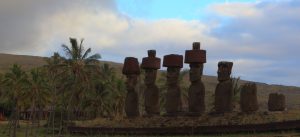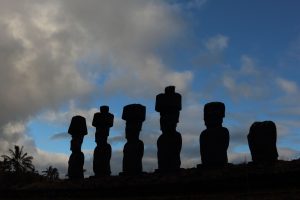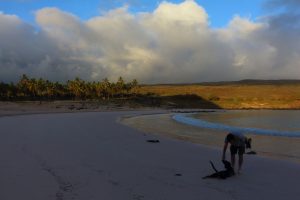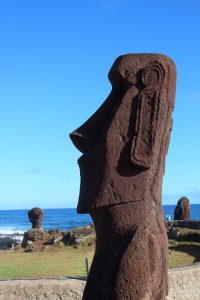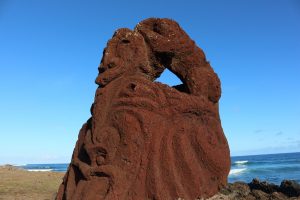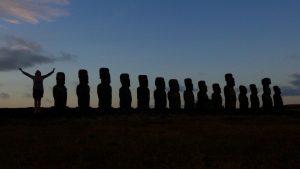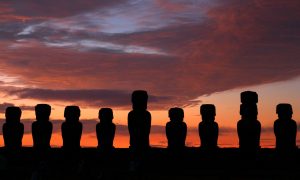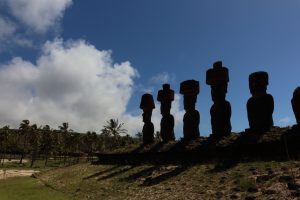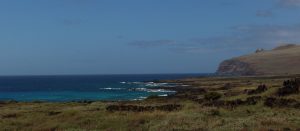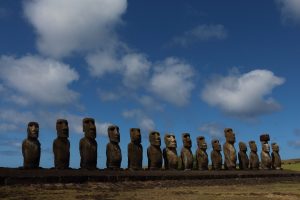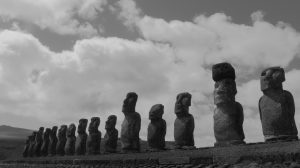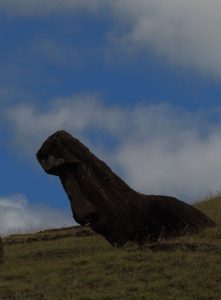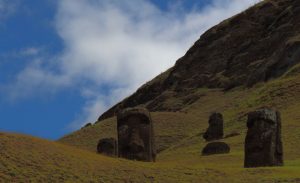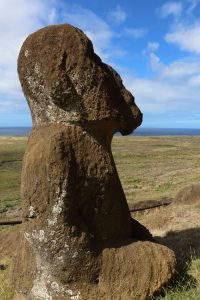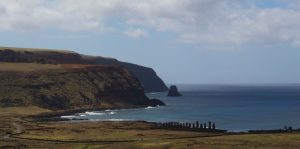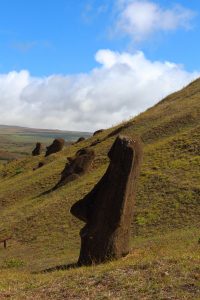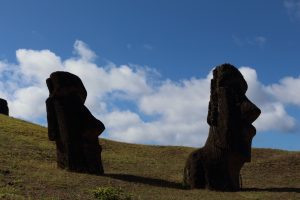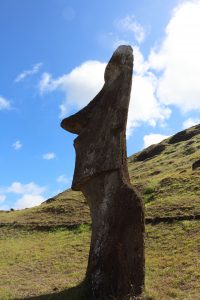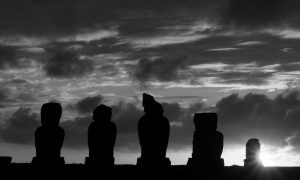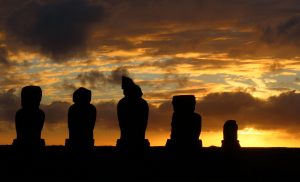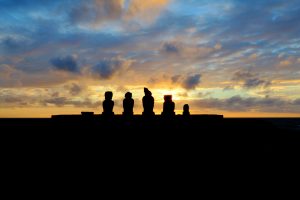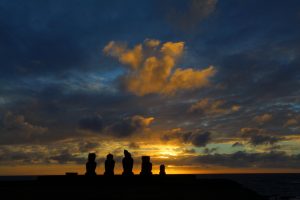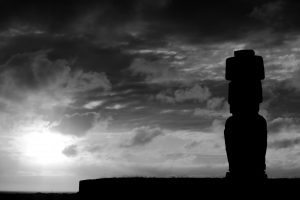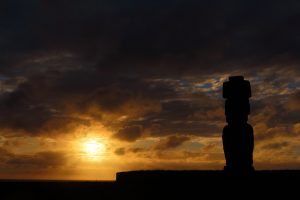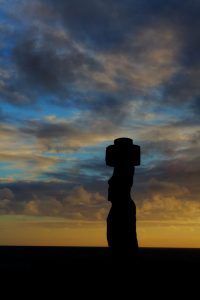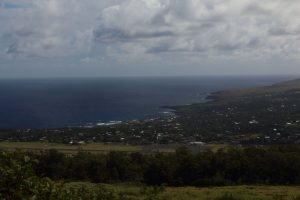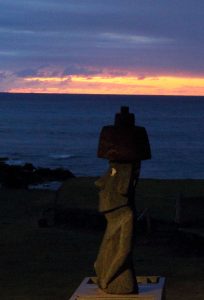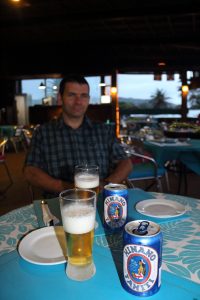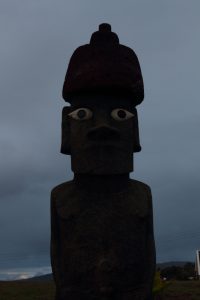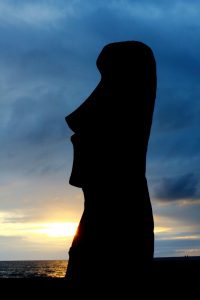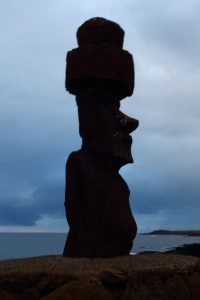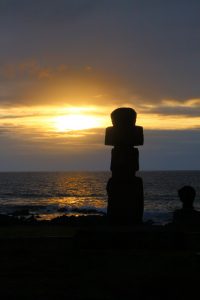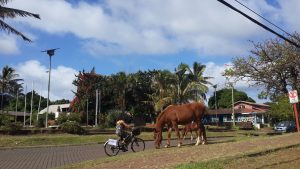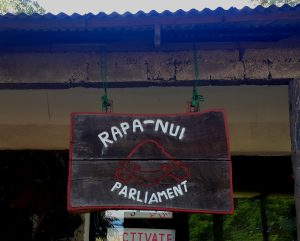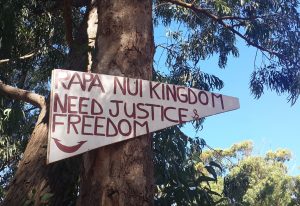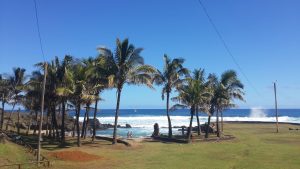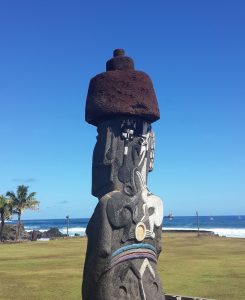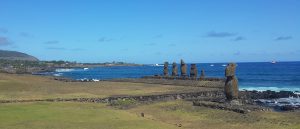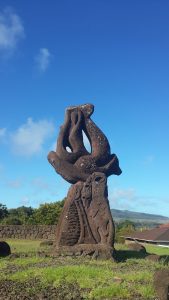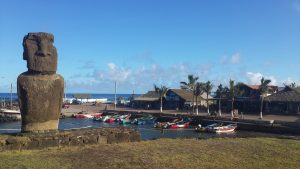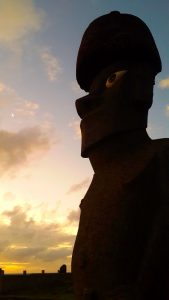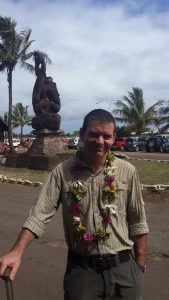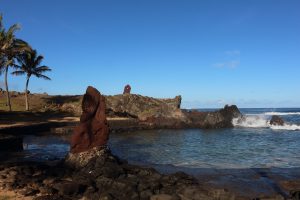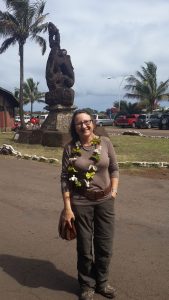Moai… everywhere, everywhere! You know those big stone-head things for which the island is famous? They’re called ‘Moai’, and there’s almost 900 of them. Many of them are either nose-planted, face-down in the dirt or buried out of sight, but a famous few are standing proud and are widely photographed. We left Cuthbert behind in Santiago for a few days and headed to Easter Island to investigate with this Easter Island blog.

Rapa Nui
Easter Island, or Rapa Nui as it’s known to local dudes, is a tiny dot mid-Pacific around five hours flight time west of Chile and just south of the Tropic of Capricorn. Politically the island belongs to Chile and Spanish is widely spoken, but geologically it’s the far eastern corner of Polynesia and the indigenous Rapanui are descendants of the early migrants from Tahiti. On arrival in the island’s only town – the not-so-sprawling but quaintly attractive ‘metropolis’ of Hanga Roa – the traditional flower garland welcome says ‘Polynesia’ (yes, Marcus just loved that bit 🙂 ) but the Latino influence means that Spanish is widely spoken. The result is a curious cultural mix of Latino-Polynesia – does that makes them Lati-sians? Or Poly-tinos? 🙂 ).
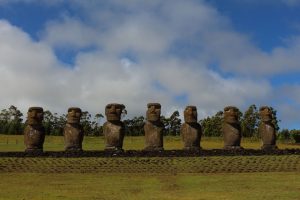 Generally the island seems a happy place, but there is clearly some tension as the Rapanui seek independence from Chile. They claim that their tourism income is pilfered by Chile and that this (alleged) US$250 million pot would allow them to stand alone in the world. Who knows? The situation is not identical to, but reminds us somewhat of the Scottish quest for independence from UK, but let’s steer clear of the politics!
Generally the island seems a happy place, but there is clearly some tension as the Rapanui seek independence from Chile. They claim that their tourism income is pilfered by Chile and that this (alleged) US$250 million pot would allow them to stand alone in the world. Who knows? The situation is not identical to, but reminds us somewhat of the Scottish quest for independence from UK, but let’s steer clear of the politics!
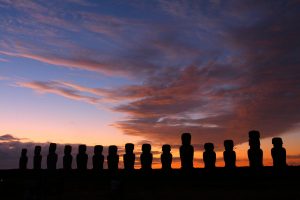 A bit less controversial… our chalet (Cabañas Ngahu) is in a great location on the peaceful coast road of the fabulously chilled-out Hanga Roa. We have great views from the room over a gorgeous bright blue Pacific Ocean but it’s also close to what passes for a town centre, a cutesie little fishing harbour and, most importantly, a tasty selection of cafes and restaurants. Marvellous! We spend the rest of our arrival day sitting in the sunshine in a breezy terrace bar, watching surfers tumbling in the waves whilst we fulfil the obligatory arrival duty of checking-out the local wines, beers and seafood. You’ll no doubt be pleased to hear that they are all indeed ‘Most Satisfactory’!
A bit less controversial… our chalet (Cabañas Ngahu) is in a great location on the peaceful coast road of the fabulously chilled-out Hanga Roa. We have great views from the room over a gorgeous bright blue Pacific Ocean but it’s also close to what passes for a town centre, a cutesie little fishing harbour and, most importantly, a tasty selection of cafes and restaurants. Marvellous! We spend the rest of our arrival day sitting in the sunshine in a breezy terrace bar, watching surfers tumbling in the waves whilst we fulfil the obligatory arrival duty of checking-out the local wines, beers and seafood. You’ll no doubt be pleased to hear that they are all indeed ‘Most Satisfactory’!
The Moai
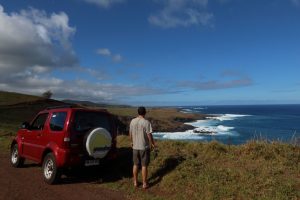 On day two we got a bit ambitious and decided to explore a bit… by bicycle! In fact it wasn’t just a bit ambitious, it was actually a bit over ambitious. It’s a few years since we did any cycling and although our chosen route wasn’t that arduous, our backsides really didn’t appreciate the combination of a hill-climb to the Rano Kau crater with a tiny, uncomfortable saddle. For a couple of days afterwards we were left regretting our misguided cycling decision and from then on we opted to hire a roller-skate instead. Sorry… did we say ‘rollerskate’? We meant ‘Suzuki Jimmy’! Not much difference between them when compared to Cuthbert 🙂
On day two we got a bit ambitious and decided to explore a bit… by bicycle! In fact it wasn’t just a bit ambitious, it was actually a bit over ambitious. It’s a few years since we did any cycling and although our chosen route wasn’t that arduous, our backsides really didn’t appreciate the combination of a hill-climb to the Rano Kau crater with a tiny, uncomfortable saddle. For a couple of days afterwards we were left regretting our misguided cycling decision and from then on we opted to hire a roller-skate instead. Sorry… did we say ‘rollerskate’? We meant ‘Suzuki Jimmy’! Not much difference between them when compared to Cuthbert 🙂
 So what’s to see in Rapa Nui? Well there’s some lovely countryside and coastline but obviously most people come to see the Moai. We’ll try not to descend into a rather dull history lecture – Mr Google can fill you in on the historical detail if you are interested – but the Moai are at least worthy of a few words.
So what’s to see in Rapa Nui? Well there’s some lovely countryside and coastline but obviously most people come to see the Moai. We’ll try not to descend into a rather dull history lecture – Mr Google can fill you in on the historical detail if you are interested – but the Moai are at least worthy of a few words.
They are, as we said, all over the place. The main ones are in well-known and much visited locations, upright and restored to a greater or lesser extent. But they are also in the most unlikely locations. Due to the protection of UNESCO World Heritage status (actually the first one ever designated by UNESCO) most Moai remain where they were found, regardless of the modern use of the land around them. So they sit in people’s gardens; by the side of the airport runway; and between the huge tanks of the island’s fuel bulk-storage facility.
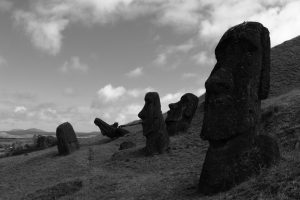 As you can see from the pics, the Moai aren’t all the same. They are said to depict tribal leaders of their time and therefore carry their respective physical traits – short, fat, tall, skinny, whatever. Some of them sport a rather fetching ‘hat’ or ‘top-knot’. These are not carved from the same stone as the body – they are always in a different pinkish rock and come from different quarry on the island to the quarry from which the bodies were hewn. Moai gurus are still arguing about the significance of the trendy top-knots, so you can make up your own theory on this.
As you can see from the pics, the Moai aren’t all the same. They are said to depict tribal leaders of their time and therefore carry their respective physical traits – short, fat, tall, skinny, whatever. Some of them sport a rather fetching ‘hat’ or ‘top-knot’. These are not carved from the same stone as the body – they are always in a different pinkish rock and come from different quarry on the island to the quarry from which the bodies were hewn. Moai gurus are still arguing about the significance of the trendy top-knots, so you can make up your own theory on this.
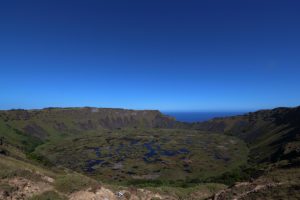 Some Moai stand alone, some remain partially buried with their heads sticking mole-like out the ground, some stand in rows on plinths, but most of the 887 chaps (and all but a handful are chaps) are buried or lie scattered and face-down like discarded dolls. The first reason for this, is in the 17th and 18th Centuries there was a lot of argy-bargy between tribes and they went around toppling each others’ moais in a ‘tit-for-tat’ act of spite. The other reason for some of the coastal Moai, is that they were toppled by a tsunami in 1960.
Some Moai stand alone, some remain partially buried with their heads sticking mole-like out the ground, some stand in rows on plinths, but most of the 887 chaps (and all but a handful are chaps) are buried or lie scattered and face-down like discarded dolls. The first reason for this, is in the 17th and 18th Centuries there was a lot of argy-bargy between tribes and they went around toppling each others’ moais in a ‘tit-for-tat’ act of spite. The other reason for some of the coastal Moai, is that they were toppled by a tsunami in 1960.
Tsunami time?
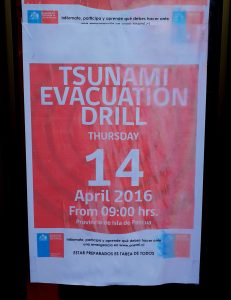 Talking of tsunami… when we arrived we couldn’t help noticing a series of government posters around town announcing a tsunami evacuation drill in a couple of days. Hmmm… makes sense, we thought. A tiny island mid-pacific would probably be a bit vulnerable… people would want to know what to do. Right? We wondered how the exercise might affect us tourists – if the big-wave were to come rolling in, they surely wouldn’t just grab granny and drive up the hill leaving us all to ride the surf would they?
Talking of tsunami… when we arrived we couldn’t help noticing a series of government posters around town announcing a tsunami evacuation drill in a couple of days. Hmmm… makes sense, we thought. A tiny island mid-pacific would probably be a bit vulnerable… people would want to know what to do. Right? We wondered how the exercise might affect us tourists – if the big-wave were to come rolling in, they surely wouldn’t just grab granny and drive up the hill leaving us all to ride the surf would they?
Our hotel owner smiled: “Nobody does anything. Maybe a bus might take the school children somewhere, maybe not. Only the surfers care… they are happy to get some extra waves”. OK. So they’re not taking this too seriously then! We laughed it off and went for a drive out of town and around the island on that day. Thinking no more about, we were surprised a few days later to hear a loud siren blasting across the town.
We had read in the BBC on-line ‘breaking news’ that there had been a significant earthquake in Japan a few hours before. Errr… it couldn’t have triggered some kind of Pacific tsunami, could it? We looked around. The view from our patio looked calm, but we couldn’t see any people. We wondered whether to sit-tight or check-it out. Turned out it was a fire drill for the local volunteer fire service. Phew! And relax!
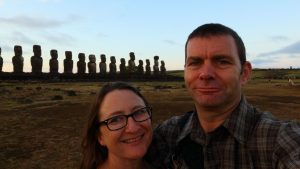 Anyway, that’s enough rambling. Easter Island is a story told far better in pictures than words. It’s a really photogenic spot, particularly at sunset and sunrise (yes, once again we found ourselves suffering the unfamiliar and painful start to the day of an alarm clock!) and we took loads of pics. It’s only a slight exaggeration to say ‘millions’ and we’ll upload a tiny proportion of them for the blog.
Anyway, that’s enough rambling. Easter Island is a story told far better in pictures than words. It’s a really photogenic spot, particularly at sunset and sunrise (yes, once again we found ourselves suffering the unfamiliar and painful start to the day of an alarm clock!) and we took loads of pics. It’s only a slight exaggeration to say ‘millions’ and we’ll upload a tiny proportion of them for the blog.
We’ve had a great time and really enjoyed Rapa Nui, such a chilled-out place. If only it weren’t so remote, we would be tempted to return sometime, but if it weren’t so remote, everyone else would be going there too and it wouldn’t be so cool. Hmmm… conundrum! Nevertheless, we have missed Cuthbert and are pleased to back with him. Next a bit more time in Santiago then back on the road. Our next report will come to you from, errr…. not sure… wild guess… probably somewhere heading north!
Link to next blog: Santiago Link to full South America home page

